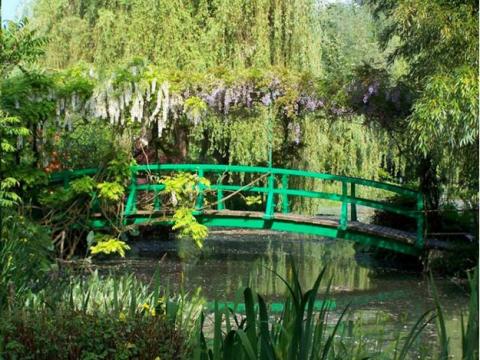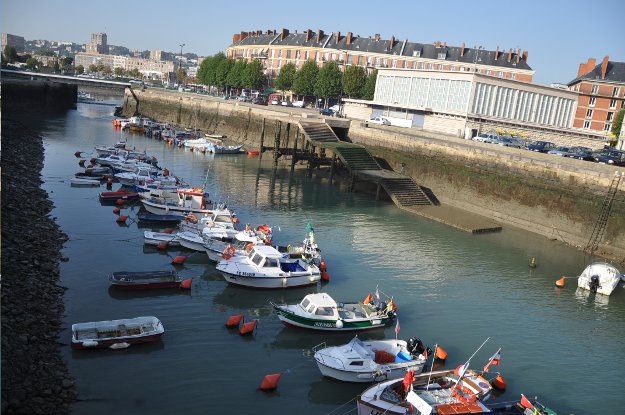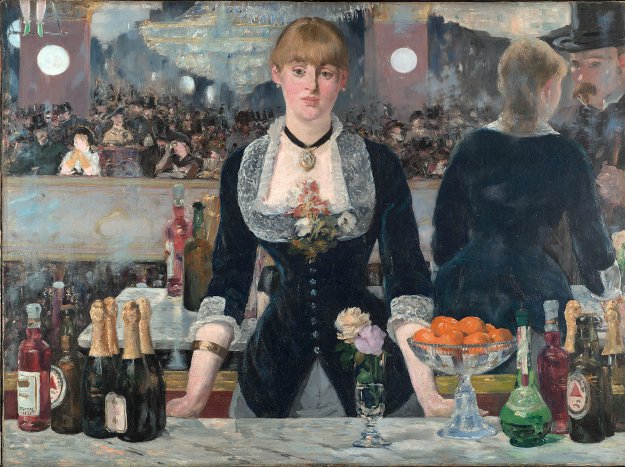The Impressionists’ Take on Normandy’s Elusive, Illuminating Light

What is it about northern France that makes it so striking? The ornate half-timbered villages, rolling pastures sprinkled with Normande cows, snow-white cliffs, and red-poppy-spangled fields for sure. But there’s also something about the light. A clarity that illumes the bright blue skies scuttled with fluffy white clouds, casting brooding shadows for an instant before brightening again. A fleeting exchange of sun and shadow that bewitches anyone who comes this way. Anyone who’s been there knows what I’m talking about.
As such, it’s no coincidence that Impressionism was born in the late 19th century on this very spot. Painters spearheaded by Claude Monet were enamored by that dazzling luminescence, and it became their mission to capture it on canvas. Monet once said: “For me, a landscape does not exist in its own right, since its appearance changes at every moment; but the surrounding atmosphere brings it to life - the light and the air which vary continually. For me, it is only the surrounding atmosphere which gives subjects their true value.”
The adorable little fishing village of Honfleur, situated where the Seine flows into the English Channel, is where much of the discussion about this light, and correlated color, progressed among Monet and his artist friends. Drawing charcoal caricatures in Paris, Monet came to Honfleur in 1858 at the bequest of his friend, Eugène Boudin, one of the first plein-air landscape artists. Boudin was determined to show his mentee what painting was all about.
They painted outdoors—outdoors!—and suddenly Monet understood his friend’s persistence. "It was as if a veil was torn from my eyes; I had understood. I grasped what painting could be,” he said. In 1872 he painted the sun rising over the waters near Le Havre. He called his work “Impression, Soleil Levant”—“Impression, Sunrise.” When the painting was shown in Paris for the first time, the art critics were not impressed. “I had merely the impression of a painting,” stated one. A whole new art movement thus was born.
Some of the art world’s most famous names tackled the Impressionist way of painting: Camille Pissarro, Edgar Degas, Alfred Sisley, Berthe Morisot, and Pierre-Auguste Renoir among them. Completely breaking from the European realist tradition, escaping the staid artist studio, they sought to depict the world at a single moment. To do this, they applied pure color in small touches – liberally using color in ways it had never been done before. Purple grass! Green clouds! And with the recent invention of portable paint tubes (not to mention the recent arrival of the railway), they could easily paint outdoors to catch those momentary impressions on the spot.
Normandy remains the beautiful land of the Impressionists, with many places looking nearly exactly as they did more than a century ago. In some sites, placards have been set up where you can compare the original scenery with the well-known artworks painted there. Museums dotting the area also display some of their works. It makes for a glorious exploration, whether you have just a weekend or a week. Here’s a quick tour of the best spots, which more or less follow the meanders of the Seine from Paris north to the English Channel.
GIVERNY
Taking the train between Paris and Normandy, Monet fell in love with a little piece of paradise along the Seine, where in 1890 he bought a house and—more famously—planted his gardens. Living here for more than 40 years, he painted some of his most famous works, notably depicting the Japanese bridge and his water lilies. The pink manor house and gardens in Giverny remain one of the art world’s best places to gather insight into an artful mind. Nearby, the Musée des Impressionismes, located in the field where Monet painted his series of haystacks, is devoted to Impressionism (and includes related movements before and after). The museum mounts several annual temporary exhibits and also shows a permanent exhibition entitled “Monet in the Middle.” Monet and his friends used to gather at the Restaurant Baudy, just down the street from the artist’s house. Retaining its turn-of-the-20th-century charm, this intimate restaurant and gardens offer hearty French cooking—or stop by for a café au lait.
There’s another artistic garden nearby of note. Postimpressionist Pierre Bonnard painted many of his most famous garden scenes at “Ma Roulotte,” his summer chalet in Vernonnet, just a few miles from Giverny on the Seine. Monet and Bonnard visited each other often, though their garden philosophies differed. While Monet was a serious horticulturist, Bonnard believed in the jardin sauvage—wild garden. Not much remains of Bonnard’s original garden but for the essence of his spirit, along with the striking views of the Seine, which he often portrayed. The house is in private hands, though the owners are happy to show visitors around by appointment (Bertrand de Vautibault and Daniele Teisseire, [email protected]). The A.G. Poulain Museum in Vernon also offers a collection of works by the artists of Giverny, including Monet and Bonnard.
ROUEN
Monet visited Rouen in 1892–93, obsessed in capturing on canvas the changing beauty of the Gothic cathedral throughout the day. “I had a night filled with
nightmares: the cathedral was falling down on me, it appeared either
blue, pink or yellow,” he wrote. He rented a room across the square, and from there painted more than 30 renditions of the cathedral. Sometimes he worked on 14 paintings at a time, as the lighting changed throughout the day. Be sure to visit the cathedral (noting he never once stepped foot inside – though you should; the tomb of Rollo, the Viking-cum-duke and founder of Normandy, is there). The beautiful Musée des Beaux Arts showcases one of France’s largest collections of Impressionists outside Paris, including Monets, Pissarros, Caillebottes and Sisleys. Interesting, too, are the works by Robert-Antoine Pinchon and Joseph Delattre, two local Impressionist artists belonging to the School of Rouen.

ÉTRETAT
If anyone knows Monet’s works, they’ve seen the monumental white stone arch plunging into the sea at Étretat. You can’t miss this striking icon immediately upon accessing the walkway fronting the beach, off to the left. Along the walkway, check out placards depicting the precise spots where Monet painted some of his most famous paintings. Though he wasn’t the first artist here. Realist painters Eugène Delacroix and Gustave Courbet had been here before, and Monet knew that. Upon arriving in 1883, he remarked, “I reckon on doing a big canvas on the cliff of Étretat, although it’s terribly audacious of me to do that after Courbet who did it so well, but I’ll try to do it differently.” You can hike to the top of the arch via pathway and set of stairs, gaining different perspectives of the line of dramatic alabaster-white cliffs edging both sides of town. And if you still have the energy, hike the trail on the other side, leading to an ancient church. The views just get better and better.

LE HAVRE
This port city retains the industrial feel that captivated the Impressionists as they scoured Normandy in search of new motifs—bridges, train stations, dockyards—depicting 19th-century modernization. The best reason to visit is the fabulous Musée d’Art Moderne André Malraux. In a striking setting overlooking the mouth of the Seine, this modern, light-infused museum contains a notable collection of late 19th- and early 20th-century collections, especially the Impressionists: Monet, Degas, Renoir, Sisley, Pissarro, Manet and Bonnard, as well as their predecessor, Boudin. And remember, it was off the coast of Le Havre that Monet first captured that impression of a sunrise that gave its name to an entire art movement.

SAINT-ADRESSE
The nearby village of Sainte-Adresse was another Impressionist haunt. Monet’s father and aunt lived in a villa overlooking the water in this fashionable sea resort. One of his first works depicted his relatives on the terrace by the sea: “Garden at St.-Adresse,” with the bright light highlighting the women’s dresses and parasols, a bounty of flowers all around. Stroll along the beach promenade (toward Le Havre) to follow in the footsteps of many Impressionist painters; panels depict their works on the spot they were painted.

HONFLEUR
Rated one of France’s most beautiful—and most painted—villages, Honfleur retains the 17th-century winding cobbled lanes and half-timbered houses that besotted the early Impressionists. But it’s the inner harbor, a pocket-size pool of indigo, boat-dotted waters surrounded by exquisite ancient town houses, that especially dazzles. Stop by the Musée Eugène Boudin, tucked along one of the picturesque side streets, to see some of this master’s works, as well as many by his friends, Johan Jongkind, Courbet and Monet among them. And give a nod to La Ferme St. Simeon, the inn where Monet, Boudin and other artists convened to discuss their art; though the artists were able to exchange lodging and hospitality for paintings, it’s unlikely the current-day Relais & Châteaux occupying the property will go for that. Nevertheless, the place looks nearly the same as when the artists admired its blooming apple orchards and views of salt marshes stretching out to the sea. Monet’s favorite room was No. 22.
TROUVILLE
The sea air is bracing and briny in this elegant, belle-époque village, where majestic villas front a boardwalk-edged golden beach. Boudin and Monet especially loved this town, capturing on canvas the women in their white crinoline dresses and parasols and handsome men in morning dress as they struck out on their daily promenades. And yet, Trouville remains a fishing village at heart, where gulls swoop and fishing boats head out in search of their daily catch. Take a stroll out onto the jetty, where panels duplicate a dozen or more paintings that Boudin created on the spot.

COUNTRYSIDE
The Impressionists captured many, many more places in Normandy on canvas. Driving the winding roads throughout this pastoral province, admiring the rolling fields, copses of trees, glittering rivers, and coastal views, you’ll be struck by a sense of familiarity, as if you’ve seen that view before. And it’s very possible that you have. That’s the beauty of Normandy and the legacy of its Impressionist artists.
Author Bio:
Barbara Noe Kennedy worked as an editor at the National Geographic Book Division for more than 20 years. She has written four books, and her writings have also been published in National Geographic, The Daily Telegraph, and the Los Angeles Times, among other publications. She is a contributing writer at Highbrow Magazine.
For Highbrow Magazine




























































































































































































































































































































